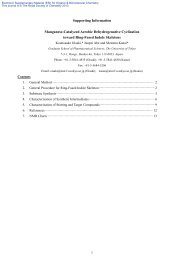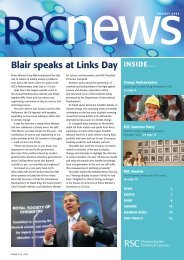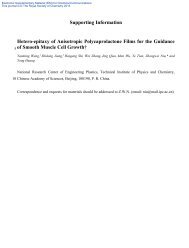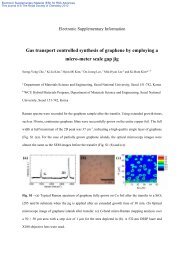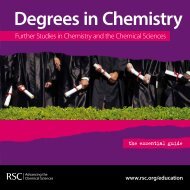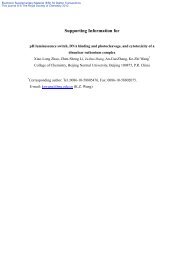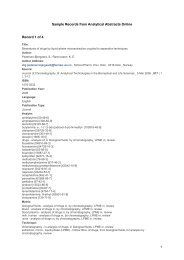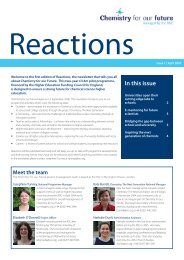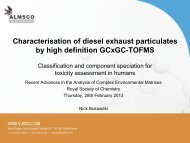Atom and molecule: upper secondary school French students ...
Atom and molecule: upper secondary school French students ...
Atom and molecule: upper secondary school French students ...
You also want an ePaper? Increase the reach of your titles
YUMPU automatically turns print PDFs into web optimized ePapers that Google loves.
A. Cokelez <strong>and</strong> A. Dumon 130<br />
Figure 7: Comparative study of the levels of description of water <strong>molecule</strong><br />
60<br />
50<br />
Answers<br />
(%/R)<br />
40<br />
30<br />
20<br />
10<br />
0<br />
L.0 L.1 L.2 L.3 L.4 L.5<br />
Grade 10 43 54 2 1 0 1<br />
Grade 11 26 52 7 11 3 1<br />
Grade 12 44 37 7 9 3 1<br />
In some descriptions of the water <strong>molecule</strong>, the following can be observed:<br />
• The notion of the polarity of the <strong>molecule</strong> (11% of grade 11 <strong>students</strong>), The idea is<br />
introduced at the beginning of grade 11, at the same time as the <strong>students</strong> answer the<br />
questions. In grade 12, only 2% of the <strong>students</strong> refer to it.<br />
• An explicit mention of the angle between the O-H bonds (5%, grade 11 <strong>students</strong>; 10%,<br />
grade 12). The accurate value is not often given.<br />
Students’ misconceptions<br />
As noted by Pereira <strong>and</strong> Pestana (1991), when dealing with the diagrams of <strong>molecule</strong>s<br />
with the help of space-filling models <strong>and</strong> ball <strong>and</strong> stick models, <strong>students</strong> do not always show<br />
the respective size of atoms: 33%, grade 10; 7%, grade 11; 15%, grade 12. The radiuses of<br />
the circles that represent oxygen <strong>and</strong> hydrogen atoms are generally equal.<br />
Some <strong>students</strong> confuse atom <strong>and</strong> <strong>molecule</strong> in the description: “the water <strong>molecule</strong><br />
consists of two <strong>molecule</strong>s of hydrogen <strong>and</strong> one of oxygen” (12%, grade 10; 3%, grade 11 <strong>and</strong><br />
8%, grade 12). In grade 10, they also sometimes refer to dihydrogen or dioxygen to name<br />
atoms (7%), thus showing confusion in their conceptions.<br />
Attributing colour to atoms in the description of water <strong>molecule</strong> (for example: “one red<br />
circle <strong>and</strong> two white circles”) remains from grade 10 to grade 12 (6%, 3%, 5%) <strong>and</strong> 8% of<br />
grade 12 <strong>students</strong> still think that the <strong>molecule</strong> possesses macroscopic properties. These<br />
<strong>students</strong> thus seem to have difficulty in distinguishing model from reality. Indeed, the colour<br />
code for atoms was developed when the representation of <strong>molecule</strong>s relied on the use of<br />
molecular models.<br />
The poor underst<strong>and</strong>ing of what the chemical formula, H 2 O, represents (Ben-Zvi et al.<br />
1988; Keig <strong>and</strong> Rubba, 1993) leads some <strong>students</strong> to produce an erroneous description or<br />
drawing diagram of the water <strong>molecule</strong>: H <strong>and</strong> 2O (or H 2 <strong>and</strong> O): 5%, 4%, 7%.<br />
Lastly, 5% of grade 11 <strong>and</strong> 4% of grade 12 <strong>students</strong> believe that the bond between atoms<br />
is of the ionic type (<strong>molecule</strong> consisting of ions or bonding resulting from an exchange of<br />
electrons between atoms).<br />
Chemistry Education Research <strong>and</strong> Practice, 2005, 6 (3), 119-135<br />
This journal is © The Royal Society of Chemistry




